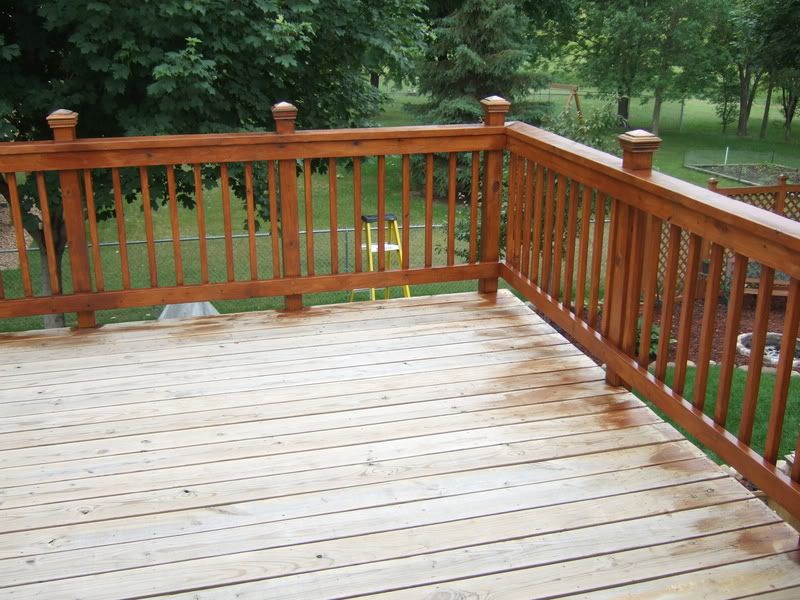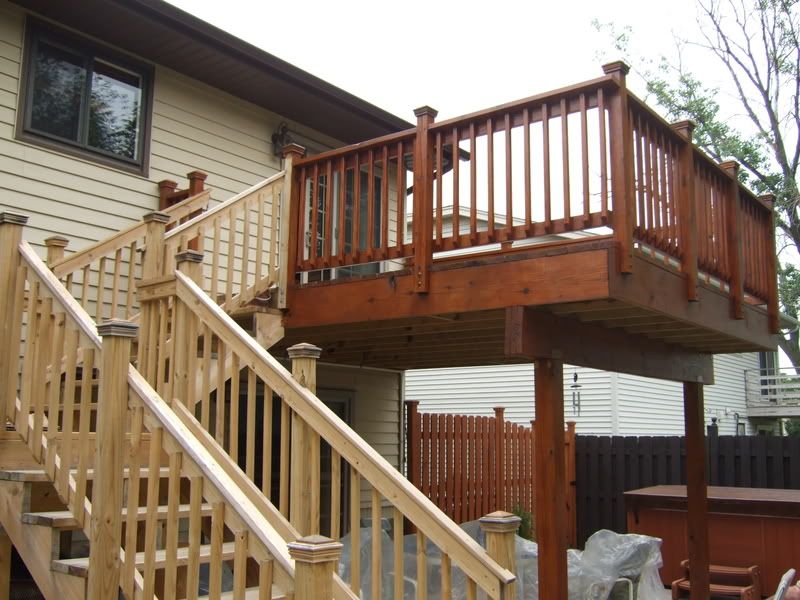 |
|
| Browse | Ask | Answer | Search | Join/Login |
|
|
||||
|
notch deck posts with router? Or skip the notching?
I'm building a deck and considering the easiest yet strong railing option. I like the vertical 2x4 on the inside of the post, one just off the deck and one just under a cap of 2x6 (actually Trex 1x6). I did this before, notching the posts about 1", which looked nice and had good support.
This is a bigger deck, the posts are already in, so notching would be a drag. One option is to skip the notching and screw the rails to the inside of the post. Another option would be to use a router to notch the posts. This seems like an obvious solution to quick and clean notches, much faster and cleaner than the typical power saw approach. I am asking because I would need to buy or borrow a router (... must... resist... more... power tools... ). Any ideas why I never see this suggested? Thanks! |
||||
|
||||
|
If the posts are already in you would have to do this notching free hand while standing next to the posts? Might be hard to keep them straight. You could try some kind of a metal bracket made for fence rails that would support the railing if you attach it directly to the posts.
|
||||
|
||||
|
I'm fishing for ideas on using a router, which is fast and clean for shallow notches; keeping it straight with a jig might work. Also, I see people just screw the rails against the post sans notches quite often. Big mistake, or bad idea? |
||||
|
||||
|
Depends on the design. If the rails are on the inside, and all the force exerted against them is from people on the deck pushing out, they will be OK, the rails themselves will break before your joint does. But people actually sitting on the railing, the nails would carry all the force and could shear off. A bracket would spread out the force, cutting the post so the rail rests on a shelf to support it causes the railing to carry the load.
|
||||
|
||||
|
Good point. My main concern is pressure out, as it is a raised deck, and a long drop off one end. No notching would cover that, but clearly notching would make a stronger railing. Having done many the traditional way described by Harold, I'm looking for something easier. I guess I shall borrow a router, give it a try, and report back. |
||||
|
||||
|
Another item I'd like to throw out there is the very common practice of putting the rails in between the posts, and toenailing them in, or perhaps using a bracket on the lower one. This seems to me to be the weakest possible rail, since now both upward and outward pressure is supported by screws.
I suppose if you cap it with a 2x6, with posts every 4', then you would not be depending on the railing inself much. However, I often see no cap board, so all the railing support is on screws. (Even with a bracket, you are still depending on screws, unless its one bad@$$ bracket, which I have not seen). Am I missing something here? |
||||
|
||||
|
Yeah... we've done it that way almost always for the bottom rail. Screws in shear (i.e. a sideways force) are actually pretty good. Its tension (i.e. pulling) you want to avoid. Pre-drill and counter sink the screws for best holding power & look. You can fill and sand the holes if you want to cover them, or use those smaller head deck screws to minimize the look.
So you do have a number of options: a) You can just use screws b) you can use brackets or clips, & screws c) you can nail your first spindle onto the 4x4 and then nail the rails into the spindle d) You could cut your 4x4 down a few inches and then fasten the top rail over top of the 4x4. Obviously the top rail would have to be wide than the 4x4. For example, if you had 1x6 as the top rail, then it would essentially span three successive posts, locking them all together. Mitre corners etc. Its quite strong. |
||||
|
||||
|
Wildandblue actually uses a chainsaw at moments like this for his "rough carpentry"
I use vertical posts toenailed to a bottom plate just like you would build a stud wall with a horizontal railing over and around the top. It took me all day pounding this with a sledgehammer to remove it when I decided after 20 years to remodel our deck. |
||||
|
||||
|
Question: a router should go through pine like a hot knife in butter, should it not? I borrowed one, and it did NOT make the job easier, but I suspect that the bit was old and not as sharp as it should be. |
||||
| Question Tools | Search this Question |
Add your answer here.
Check out some similar questions!
How can I disable my wireless router to a wired router. The model is a Linksys WRT54GS.My two computers are now in one room and do not need to be wireless.I will be using a 50ft. Cable. Does it make any difference if the color of the cable is blue or yellow ?
I am confused with "deck tables" from different sources, specifically concerning beam size for a deck. I am planning a basic deck as shown: 9677 Sources that describe the "tributary load" and "tributary length" would allow me to use as little as (1) 2x6 for the "front beam" (tributary...
Hello - I have heard from the a number of home improvement folks that when pouring the concrete for deck posts, a product called Quickcrete does not need any mixing. You simply dump it in the hole (12 inch diameter, 42 inches deep) and add water and it does the rest for you. I was wondering your...
I have a 2nd story concrete deck made with Polydeck... new construction home... and wish to put up railing... Would like to use aluminum balusters that look like wrought iron, probably "Deckorator" line... and Trex post and rail supports... But what would be the best method to attach the Trex posts...
I'm planning to build a deck attached to the end of my house. It will be 12 feet out from the house. The posts will be 2 x 10" concrete blocks (to be covered with artificial stack rock). How far apart can my posts be. Is 12.4foot centers too far apart? This would cause about 11 foot of span between...
View more questions Search
|









